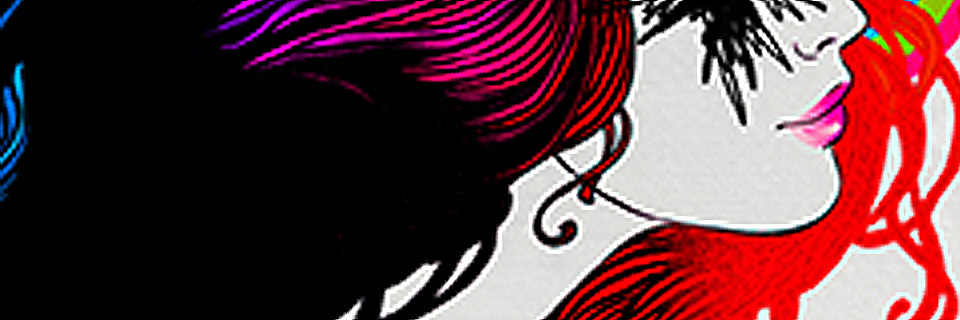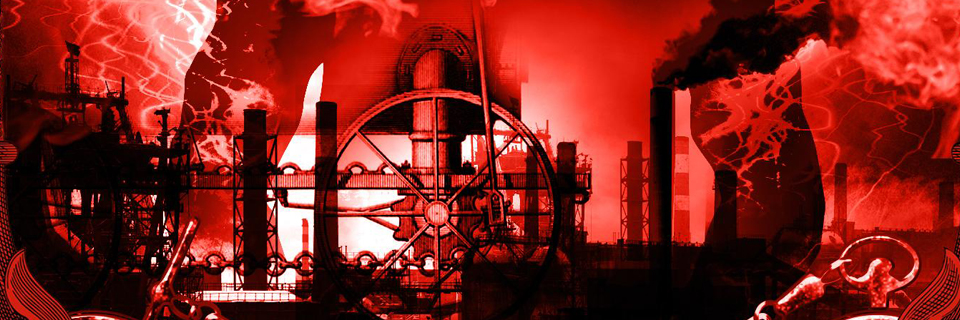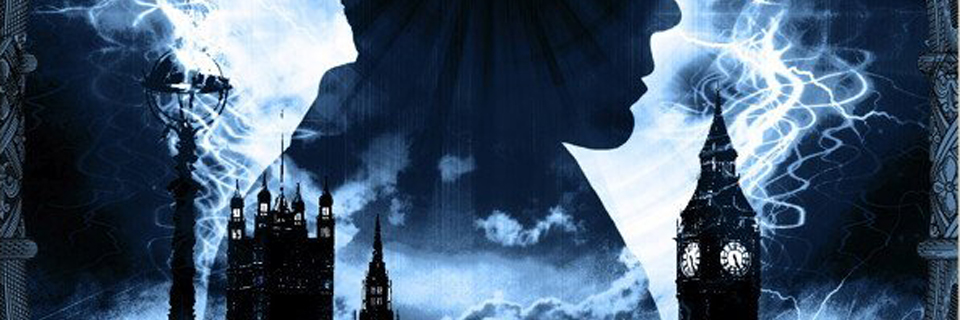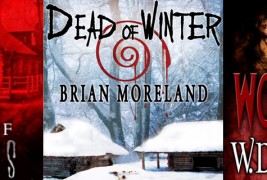
“…and in the midst of this pestilence an end…” -Giovanni Villani
The printed medium has been around for about as long as humans have; ever since the first human discovered they could smear more than feces and blood onto cave walls to leave messages, the field of writing established itself. In fact, animals have always used a system of sensory cues, from olfactory to visual, to silently communicate dominance, willingness to mate, territory, or varying levels of toxicity. This could be seen as a primitive protoscripture that uses sensory cues instead of depending on abstract symbols to put forth a message. While the aesthetic and betimes malodorous qualities can be argued and discussed, the simple fact remains that all of them are used to communicate –in one way or another– one simple, eldritch, primeval concept: Fear.
More than anything else, Fear is what shapes the human experience. The conditioned reactions and archetypical phobias instilled into our minds come from the constant fear that pervades our existence. The fabric that comprises the tapestry of our mythos is a network of tales expressing Fear in all of its incarnations out of a Jungian evolution. Predators grew with each telling, becoming monsters of gargantuan proportions and power; humans afflicted with unexplained behaviors showed that anyone is susceptible to fall under nefarious influence; the dark and the unknown became realms inhabited by forces beyond any control or understanding. Previous to the understanding of the Germ Theory of disease, the spread of contagion fell upon entire civilizations with the incomprehensible power of a wrathful god.
With this in mind, it isn’t much of a surprise that fear has infiltrated itself into our literature. Stories that raise the pulse rate, dry the mouth, and cause a jump at every noise have been written down ever since the first stick figures were carved onto a baked tablet. From the Epic of Gilgamesh to Beowulf, Hydras to blood-sucking turkeys; from the grotesque to the arabesque, the impossible to the quotidian: humanity loves to record its fears for posterity, whether as a warning or to titillate on a dark and stormy night.
One of the foremost purveyors of horror literature in recent years had been Leisure Books, an imprint of Dorchester Publications. Established in 1971 as a publisher of mass market paperbacks in the thriller, western, and romance genres, its selection of horror was paltry until the arrival of noted editor Don D’Auria, who led the line as it published award-winning books. Invigorated like the upyr full of fresh blood, a slew of successes emerged from noted authors.
Alas, as anyone at all aware of the situation in the publishing world, the costly production of books becomes less and less viable, so many companies either went out of business or were forced to restructure their business. Afflicted with decreased sales and mired in allegations of unfulfilled obligations to their authors, Dorchester decided to shutter Leisure. According to author Hunter Shea, “They lost almost all of their authors thanks to their mismanagement and philosophy-change. It was such a shame.”
After leaving Leisure, Mr. D’Auria was quickly snatched up by Samhain Publishing, a Macon, Georgia-based publishing house that focused on the romantic and erotic romance genres. Although founded in 2005, it was only recently that in an attempt to expand their output, Samhain hired Mr. D’Auria to head their horror line; it was announced in January of 2011. With such a well-known editor in charge of its new horror line, Samhain quickly set about acquiring the best from true heavyweights within the field of horror publishing. Officially launched in October of 2011, the Samhain horror line opened with a bang, publishing titles from a variety of award-winning authors. You can check them out at www.samhainpublishing.com/horror.htm.
Ravenous Monster has been given the august opportunity to interview three of Samhain’s talented authors. In this interview, Hunter Shea, William D. Gagliani, and Brian Moreland will answer questions about the effect that the demise of Leisure had on their careers, Samhain Publishing, Polynesian ghosts, cannibal plagues, lycanthropic police, honing their craft, the state of horror, and their deepest, darkest secrets. Well, maybe not the last one. But, maybe yes. We’ll see.
RavMon: Tell us about your new book…?
Shea: [Forest of Shadows] My favorite horror stories always involve ghosts, so I wanted to create a modern day ghost story centered around a modern day ghost hunter (even though the writing started before all of the ghost hunting stuff you see on TV now). Forest of Shadows is about a man who wins the lottery on the same day his wife dies. He’s left with millions, but also a severe case of anxiety disorder and survivor’s guilt. A quasi-recluse in his home with his young daughter, he turns his energies to exploring the paranormal, creating a website that is a library for all things strange and unexplained. He does a little ghost hunting on the side, and as part of his therapy, makes the bold decision to move to a haunted cabin in Alaska for the ultimate hunt. What seems like a good idea at first turns into utter mayhem as he struggles to unlock the secrets buried in the house, and the town itself, before the cold season traps them for the long, Alaskan winter.
Forest of Shadows is a ghost story amped up to eleven. I added a dash of subtle suspense and a sprinkle of over-the-top chills to hopefully make my readers alternate between cringing with anticipation and afraid to see what’s coming up next.
Gagliani: Wolf’s Edge is the 4th Nick Lupo horror/thriller after Bram Stoker Award finalist Wolf’s Trap, Wolf’s Gambit, and Wolf’s Bluff. Wolf’s Edge is being released as an eBook by Samhain Publishing on October 4, 2011, and as a trade paperback on January 3, 2012. Samhain is also reissuing the first book, Wolf’s Trap, in March 2012. That puts the middle two books, Wolf’s Gambit and Wolf’s Bluff, into a sort of gray area. They are available from my old publisher, and also directly from me (and I have 2- and 3-book deals with free shipping).
Here’s the back cover blurb for Wolf’s Edge:
“Can one werewolf stop a pack of super-wolves?
Nick Lupo is a homicide cop with a difference. He’s a werewolf. He’s worked hard to control his condition, but it isn’t easy to contain the beast inside him. It also means he has some very powerful enemies. Wolfpaw Security Services is a mercenary organization that wants Lupo dead. They want to infiltrate the US military with their own werewolves and they can’t let anyone—especially a fellow-werewolf like Lupo—stand in their way.
Wolfpaw’s genetic experiments have created a “super-wolf” nearly invulnerable to silver, and soon their ranks will be filled with these invincible warriors. Can one wolf—even a fierce beast like Lupo—face the fangs and claws of a pack of these killers and hope to survive?”
You can also read more about the series at the ITW’s Big Thrill site.
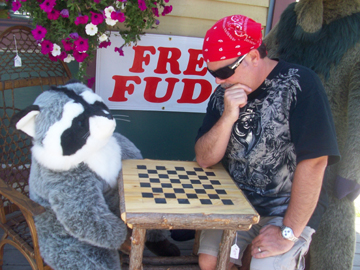
Moreland: [Dead of Winter] It’s great to be here along with my friends, Hunter Shea and W.D. Gagliani. My latest horror novel is a historical story based partly on true events and an old Algonquin Indian legend that still haunts the Great Lakes tribes to this day. It’s also a detective mystery. The story takes place near the end of the 19th Century at an isolated fur-trading fort deep in the Ontario wilderness. The main character is Inspector Tom Hatcher, a troubled detective from Montreal who had recently captured an infamous serial killer, Gustav Meraux, known as the Cannery Cannibal. Gustav is Jack-the-the-Ripper meets Hannibal Lecter. Even though the cannibal is behind bars, Tom is still haunted from the case, so he decides to move himself and his rebellious teenage son out to the wilderness. At the beginning of the story, Tom has taken a job at Fort Pendleton to solve a case of strange murders that are happening to the fur traders that involve another cannibal, one more savage than Gustav Meraux. Some predator in the woods surrounding the fort is attacking colonists and spreading a gruesome plague—the victims turn into ravenous cannibals with an unending hunger for human flesh. In Tom’s search for answers, he discovers that the Jesuits know something about this plague. My second main character is Father Xavier, an exorcist from Montreal who is ordered by the Vatican to travel to Ontario to help Tom battle the killer causing the outbreak.
RavMon: Mr. Shea, how difficult was the change from writing short stories to writing a novel?
Shea: I actually think short stories are harder to write than novels because you have a finite, limited space to build an entire world, complete with creeping tension, spills, chills and thrills. They are, by far, the best way to hone your writing skills. The most difficult part of writing a novel is its scope and maintaining that energy throughout a writing process that can take anywhere from a year to much, much longer. There’s always a fear that the concept will peter out around page 75, and then what do you do? Writing a novel does teach you discipline and you get the joy of really delving into characters, places and situations, allowing the story to move you in whatever direction it feels it needs to go. The revision process on a novel is massive compared to a short story. I always make sure I’m working on short stories while I write a book just to keep my mind fresh and the ideas flowing.
RavMon: How do you feel starting over with a new publisher after publishing with Leisure Books, Mr. Gagliani?
Gagliani: I felt excited because, first, I was still writing for my long-time editor, Don D’Auria, with whom I have always had a wonderful relationship. Secondly, I felt excited because I knew that Samhain is a place many readers go to for a wide variety of fiction in all genres, and the chances of my books being discovered by new readers were very good for the first time. I’ve found, over the years, that paranormal erotica and open-minded paranormal romance readers embraced the Wolf books as much or maybe even a little more than the horror community, so having them available under the Samhain imprint will put them in front of many readers who might not have seen them when they were classified as Horror only. Really, I think of them as horror/thrillers, and I call them North Woods Noirs.
RavMon: What kind of troubles did you have releasing your book, i.e., finding a publisher, with the demise of Leisure Books, and the subsequent move to Samhain Publishing, Mr. Shea?
Shea: Oh, the troubles I’ve seen! When I finished Forest of Shadows, I made a commitment that I only wanted it published by Leisure and edited by Don D’Auria. Totally crazy, but when I set my mind to something, I’m locked in. I sent a query to Don at Leisure while attempting to find an agent. It took several years of back and forth with Don, but my dream of making it from the slush pile to publication came true last spring when Don sent me an offer letter. While I was saying yes to him, I emailed my small list of top agents that I would like to represent me and was over the moon to hook up with Louise Fury at the L. Perkins Agency. All that happiness turned south in a hurry when Leisure imploded over the summer and my deal was never made official. I was devastated. Thank God for Louise, who kept my spirits high and gave a timeline for us to wait and see where Don landed. Mercifully, he came to Samhain and was still interested in my book and here we are today, rolling out a brand new horror line.
RavMon: Mr. Gagliani, how did you react when Leisure was unable to release your latest book?
Gagliani: Very disappointed, then concerned that my career was over! I published three books with Leisure: Wolf’s Trap, Wolf’s Gambit, and Wolf’s Bluff. They had purchased the fourth book, Wolf’s Edge, which was to be published this fall. When Dorchester/Leisure announced the major changes in their business model last year, I was willing to stay and ride them out. However, a couple weeks later they terminated my editor, the legendary Mr. Don D’Auria, and I predicted Leisure would seek bankruptcy soon. I was wrong, it appears, but as they had not yet paid me for the fourth book (and were not likely to pay previous royalties owed, either), I chose to pull that book. It’s not so much that they were unable to publish it — I requested my rights back due to nonpayment as per their own contract terms. I have also requested my rights back on the other three, but so far only one has been granted.
RavMon: Mr. Moreland, how do you feel about getting your book published through a publishing house right away rather than self-publishing and then having it picked up like your first book was?
Moreland: I absolutely love that this time around I got to skip the self-publishing step. I no longer have to do all the work myself. In fact, my editor Don D’Auria and the Samhain staff have made the whole pre-publication process quite easy for me. The art department handled the cover design and the folks in Samhain’s marketing department have done a great job posting news about our new horror line on several websites and in horror magazines. And I’m having a great time releasing my book alongside other authors whom I respect. We’ve been supporting one another and helping each other get the word out. The first time around I felt like it was me against the world. This time I have a team helping me get my book out on the market and promoting it.
RavMon: How did you get into contact with Don D’Auria, and how did it develop into getting published on Samhain Publishing?
Shea: I initially knew of Don by studying the horror market and pinpointing my dream publisher. I’d known since the 90’s that Don was the man responsible for giving a home to my favorites like Richard Laymon, Brian Keene, W.D. Gagliani, Tim Lebbon, the list goes on and on. So, when I was ready to submit a book to him, I sent an un-agented query and prayed.
I honestly don’t know how things would have turned out if I didn’t have Louise as my agent. I did my homework over the years and knew that her agency had worked with Don several times in the past. When Don left Leisure, I didn’t hear from him until he got to Samhain. Louise was key in keeping in contact with him during that limbo time where we didn’t even know if he would be editing horror. There was a lot of uncertainty and nail biting. In cases like that, having an agent is mega important, especially if you don’t have a prior relationship with an editor or publisher.

Gagliani: I kept in touch with my previous editor, and also kept an ear to the ground. When Mr. D’Auria went to Samhain, I was able to sell him the book for the second time. I’d always had a great relationship with Don, and had no problem approaching him to see what he was looking for. As he was interested in building a whole new horror line, and I had a book ready to go which he already liked enough to buy once, it wasn’t hard to make the deal. I am definitely grateful to him for making me part of the Samhain Horror roll-out, along with the legendary Ramsey Campbell, great veterans such as Ron Malfi and Greg Gifune, and some talented new voices such as Hunter Shea, Brian Moreland, Kristopher Rufty, and others. One great thing is that Samhain is willing to look at novella-length work, so I’m sure we’ll be seeing more of those.
Moreland: My agent and I were trying to find a good fit for my new book. I had finished Dead of Winter in November of 2009 and was eager to sell it to a publisher right away. That’s how I feel after finishing a novel. I just can’t wait to share it with readers. But in 2009, publishing houses were shuffling their editors like a Vegas dealer shuffling cards. My agent was afraid my book would get bought up and then lost in the chaos, so she told me let’s wait it out. It was tough to do, but we held out from submitting my book for over a year. I’m glad we did, because we were ready and waiting for the right opportunity. And then in January of this year my agent told me that Leisure Books was dissolving their horror line and that their editor, Don D’Auria had moved over to Samhain Publishing to start up a brand new horror line called Samhain Horror. Don wanted to start the line in October 2011 and was looking for submissions. We submitted my book within about two weeks of Don starting his new job. My agent sold me on Don, saying he was a legend in the horror business. I hadn’t heard of him, but I did a little research and discovered that he had been the editor for many of my favorite authors—Brian Keene, Richard Laymon, Ronald Malfi, and Jack Ketchum, to name a few. On his blog, Brian Keene wrote a post about how much he loved working with Don D’Auria. I flipped through a dozen books by Leisure authors and read the Acknowledgements. Again and again, I kept seeing Don’s name being praised, many describing him as the nicest editor to work with. That sold me, so I told my agent let’s submit Dead of Winter to Don at Samhain. Less than 30 days later in February, my agent called back and said that Don loves my book and wants it to be one of the first books to release in October. I was so excited. With my first novel I had to wait over a year to see my book in print. With Samhain, my novel released eight months after we concluded the book deal. And working with Don has been a dream. Like everyone says, he is the nicest guy and very diplomatic in his style of editing. He made some great suggestions on how to improve my novel while keeping most of the book intact. With Don and Samhain, I definitely feel like I’ve found a home to publish my future books as well.
RavMon: Where do you see your career going?
Shea: I was recently at a conference where R.L. Stine spoke and he said the key to his career success was to never say no to writing projects because you never know where it will take you. I’ve been very busy this last year writing, promoting and learning the ins and outs of the business. There is just so much that books and classes can teach you. Over the past year, I also sold a children’s book to Random House, so I’m doing a lot of work across two very diverse genres. I have another horror novel coming out with Samhain next spring called Evil Eternal and I’m working on a sequel to Forest of Shadows. Along with that are short stories for some anthologies and building up the Monster Men video podcast I do with my buddy, Jack Campisi. I’m in this, hopefully, for the long haul. I don’t mind heavy lifting and I absolutely love writing. Where it all eventually takes me is up to the fates.
Gagliani: I’m plotting the fifth Nick Lupo novel. I’m finishing a Nick Lupo novella I’m publishing independently. I’m working on a collaborative project with authors John Everson and David Benton, as well as several different projects with David Benton including our pseudonymous middle grade series, The Stoker Legacy (the first book is I WAS A SEVENTH GRADE MONSTER HUNTER and is available now). I’ve also self-published a hard-noir thriller, Savage Nights, on all major electronic formats, as well as a collection of stories, Shadowplays, and a mini-collection of my collaborations with David Benton, Mysteries & Mayhem, along with a couple shorter works such as the novella The Great Belzoni and The Gait of Anubis. I’m planning to bring back the protagonist of Savage Nights in a new novel, and there are a couple more collaborative projects waiting in the wings. I certainly have more ideas and projects than I have time! More burners than stove. I hope my career will continue to progress – after having thought it was over! – and I am expecting my association with Samhain to play a large role. I don’t expect to ever get rich, but if I can tell stories that want to bubble out of me, and find an audience that cares to go along for the ride, then I’ll be happy. I feel the sands of time working their way through the hourglass, though, and it’s giving me a sense of urgency.
If anyone wants to find me, look for me online. Currently my website, www.wdgagliani.com is the most updated (the other will be soon). I can be found on Facebook and also on Twitter, at @WDGagliani.
Moreland: Now that I’ve published two books in the U.S. and one in Germany, I’m focused on building a body of work that I can be proud of and leave behind a legacy that entertains millions of book lovers and inspires other authors just as Stephen King, Dean Koontz, H.P. Lovecraft, Richard Laymon, and a cast of others have inspired me. I’d also like to see my books hit the New York Times best-sellers list, published in multiple languages, and be made into movies. That’s the biggest dream since I was a kid watching monster movies—to go to a movie theater, order a tub of popcorn, and watch a blockbuster movie that opens with the credits, “Based on the novel by Brian Moreland.” I still believe this vision will one day manifest.
RavMon: What is your opinion on the state of horror today, especially horror books?
Shea: I think horror is poised for another big wave. I’ve seen a lot of smaller publishers jump into the horror fray and scoop up some amazingly talented writers. Samhain will hopefully be the new Leisure, but there’s also Deadite Press, Thunderstorm Books, Cemetery Dance and a slew of others putting out quality books. When it was just printed books in stores, horror was in trouble because it got very little, if any, shelf space. If you saw a horror section, it was loaded with Andrews, King and Koontz. Not much room for anyone else. With the proliferation of e-readers, fans are exposed to more horror than ever before by voices old and new and terrific. I truly feel that the next phase for horror will be even bigger than the craze in the 80’s.
Gagliani: Personally, I’m tired of hearing about the “death of horror.” I’ve been hearing that since about 1991. I think horror is alive and well, even if it’s spread out over other genres such as paranormal romance and thrillers. You see horror elements crop up in a lot of work these days, and I think that’s a good thing. Movies have helped move horror elements into fantasy and science fiction, too, as well as thrillers. Sure, there isn’t as much cross-over between movie audiences and readers as we would like. On the other hand, self-publishing and eBooks (thanks first to Amazon’s Kindle) are bringing horror to more readers than publishers have done in a long time, and that can only be good. It also proves that there’s an audience hungry for horror, and eBooks are filling a need neglected or at least underappreciated by most publishers. I’m not afraid of the supposedly poorer work being self-published – readers will seek out the better stuff, and the fact that sub-par work occasionally does well indicates the need for more work. Fortunately the small press and the newer digital presses are moving to fill these needs, and the lesser work will improve or be lost in the crowd. I think happy audiences will have more and more choices – and that can’t be bad for the horror field.
Moreland: I definitely see horror on the rise for books. Movies have been pretty steady for the past decade. The type of horror keeps changing whether it’s slasher films, movies like Saw, or vampires or zombies, it seems like every year there are at least a dozen horror films to go see at the movies. As for books, the horror genre was down in the ‘90s through the mid 2000s. I couldn’t sell anything. Every agent kept telling me, “Horror is dead.” But that seems to have changed in that last four to five years, and now people are reading vampire, werewolf, and zombie novels and talking about horror feverishly on Twitter, Facebook, and Goodreads. My agent was right about being patient. She told me to just ride out the slow years and keep writing fiction. That’s what I did and now with two books out and more on the way, I’m in great position to feed the rabid horror readers with more fiction.
RavMon: Do you have any habits or needs for when you’re writing?
Shea: I need to listen to music, but it can’t be anything with actual singing because the words start circling round my head and I lose the thread of what I’m writing. I also tend to match the music to the theme and feel of the work, so if I’m writing an action sequence, I’ll pop in the soundtrack from The Matrix. If it’s dark and creeping and foreboding, the soundtrack for There Will Be Blood gets popped in. Wagner works great for writing horror, too.
When I write, I traditionally had to put myself into a manmade cocoon and just tap away. Because time is limited and I have so many projects going on, I’ve had to teach myself to write anywhere. A perfect example of this was the day I had a 5 hour layover at an airport in Texas and spent that time, in a bustling terminal, writing. I managed to make all of the people and noise go away and lost myself in the book. I think meditation helps build concentration and is something all writers should explore.
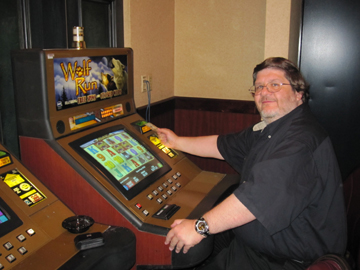
Gagliani: Since late 2008, when I had to finish GAMBIT rather quickly, I’ve found myself spending a lot of my writing time at a nearby Starbucks, where I’m able to mostly filter out the noise and people and work a bit more efficiently. At home, too many distractions call – movies, music, things to do, and so on. There’s music at the Starbucks, but I’m not as invested in it as I would be if I chose it, so it can settle into the background. Also, I’ve found myself writing more longhand lately, just working out scenes and portions with a pen and legal pad. Then when I transcribe them, I edit and revise, so it’s almost like a separate draft. If feels good to go back to using the hand to write, in some weird way. I’ve talked to some other writers who are doing it that way, too. Maybe it’s a bit of a computer backlash, I don’t know. It’s a strange compulsion, but it’s harmless enough to let it do its thing!
Moreland: Yes, I like to write for several days straight without any obligations other than writing. I have a friend’s cabin in the woods in East Texas that I like to drive out to and completely unplug from my life in Dallas. No emails. No internet. And my phone stays off most of the day. I’ll stock up the fridge with food and rent a few horror movies from Blockbuster. For a stretch of five or six days I’ll completely immerse myself in my novel, and get into the frame of mind needed to write scenes that put my characters through every kind of emotion from fear and terror to lust and desperation. I like to write high-adrenaline action and take my characters to hell and back, and this quiet space in the woods gives me the focus that I need. At night, when the darkness is pressing up against the windows, I can get pretty spooked by myself out in the woods and that paranoia transfers over to my story.
RavMon: Have you ever had any paranormal experiences?
Shea: I’ve actually had two, with one of them inspiring an event that occurs in Forest of Shadows. When my wife and I were first married in 1992, she became deathly ill and was, at one point, on life support at home for a year. During that year, I kept seeing a small boy in our house dart through our hallway and into our bedroom. When I would run in there, I only saw my sleeping wife. I assumed I was just stressed out and kept it to myself because A.) I didn’t want anyone to think I was losing it and B.) my wife had enough on her mind. When she got better, she said to me one day, “You know, it was nice to have that boy sit with me when I was sick and you were at work.” It blew my mind and proved to me that we had both been experiencing something that can’t be explained. I’ve been a firm believer in ghosts ever since. Writing a book like Forest of Shadows was a pleasure as much as a form of exorcism.
Gagliani: Yes, I’ve had a couple run-ins with what might have been possibly ghostly phenomena (but I can’t be sure), and a few strange experiences back when I was learning about the Tarot. I have about a dozen decks, but I tend to refuse to use them for anything but enjoying the artwork these days. They’ve given me the chills on some occasions. I have an Aleister Crowley deck with beautiful artwork, and I refuse to do any readings with it. Call me superstitious. My Italian heritage is full of superstition, and a few of those stories my grandmother told when I was little have found their way into my books. Let’s say I’ve seen enough to be only partially a skeptic – I’ll sit on the fence when it comes to the paranormal.
Moreland: Yes, funny, I was just discussing this with Hunter Shea earlier today at the Samhain Café where Samhain authors gather to talk about books with readers. I used to live in Hawaii on the island of Maui. I also island-hopped a lot. I remember one retreat I did on Kauai. I was staying with a group of people at a house we rented for the week. It backed up to a beautiful golf course surrounded by mountains with waterfalls. You wouldn’t think this was a scary place, but the three-story house definitely had some weird joo-joo energy. My friend and I were chatting one day in one of the bedrooms, and this lamp next to us kept blinking. I jokingly asked the lamp if it was a ghost and it blinked once as if answering. I got this eerie feeling. I told the lamp to blink once for “yes” and twice for “no.” Then for the next hour we asked it questions, and the lamp would blink once or twice in response. It seemed to communicate with some kind of intelligence. When I asked the lamp if it was possessed with a ghost it blinked “yes” every time. I even stopped asking questions for five minutes and the lamp turned off. When I started asking it again, it started blinking as if waiting for my questions. It was freaky. Now, Hawaii is known for having all kinds of spirits. After the lamp incident the lady in charge of the house told us the place was haunted.
I also had an instance where I was walking on a beach at night on Maui and I swear I saw ghosts of Hawaiian people dressed in ceremonial garb on the beach. They were all smaller than me and my first thought was I was witnessing the legendary Menehunes, which live in Hawaiian mythology. I saw at least a dozen of them dancing on the beach for a split second and then they were gone. I never felt threatened, but I was definitely spooked.
Hunter Shea has written various books and has had his short stories published in myriad magazines. Links to purchase his latest short stories and book, Forest of Shadows, can be found on his website huntershea.com. Follow him on Twitter @huntershea1 and you can also follow him on FaceBook at www.facebook.com/huntershea1.
William D. Gagliani has been included in many prestigious anthologies and has been nominated for the Darrell Award and the Bram Stoker award. He grew up in Kenosha, Wisconsin and Genova, Italy, although he now resides in Milwaukee, Wisconsin. In addition to his acclaimed Nick Lupo series, he has also published interviews, essays, articles, and short stories. For more information, visit his website www.wdgagliani.com.
Brian Moreland writes novels and short stories of horror and supernatural suspense. He loves hiking, kayaking, rock climbing, and dancing. Brian lives in Dallas, Texas where he is diligently writing his next horror novel. You can communicate with him online at brianmoreland.com or on Twitter @BrianMoreland, Brian’s blog: www.brianmoreland.blogspot.com, and Excerpts of Brian’s fiction blog: brianmoreland.wordpress.com.


